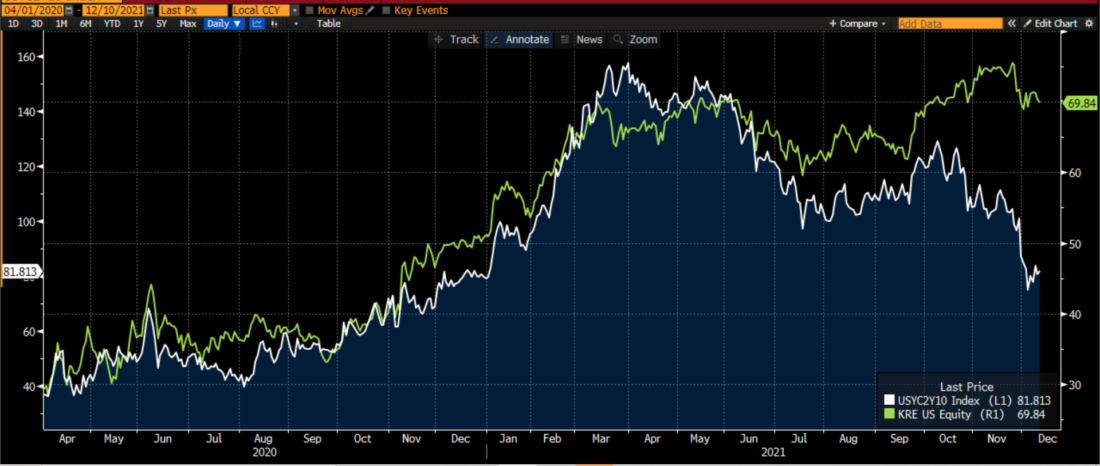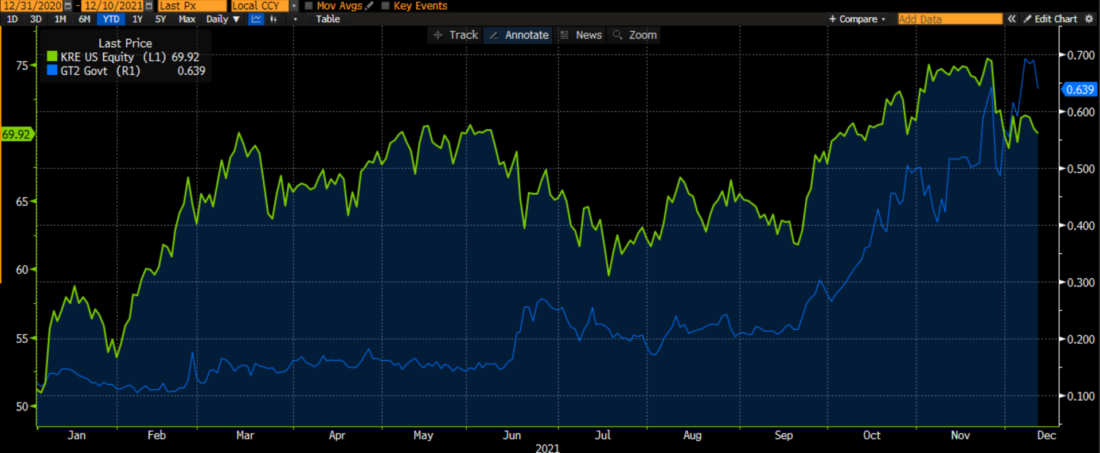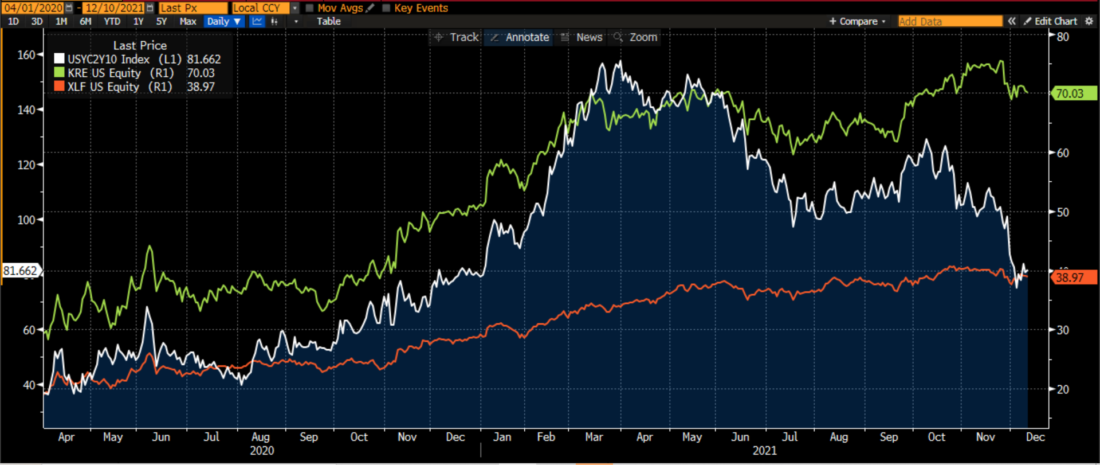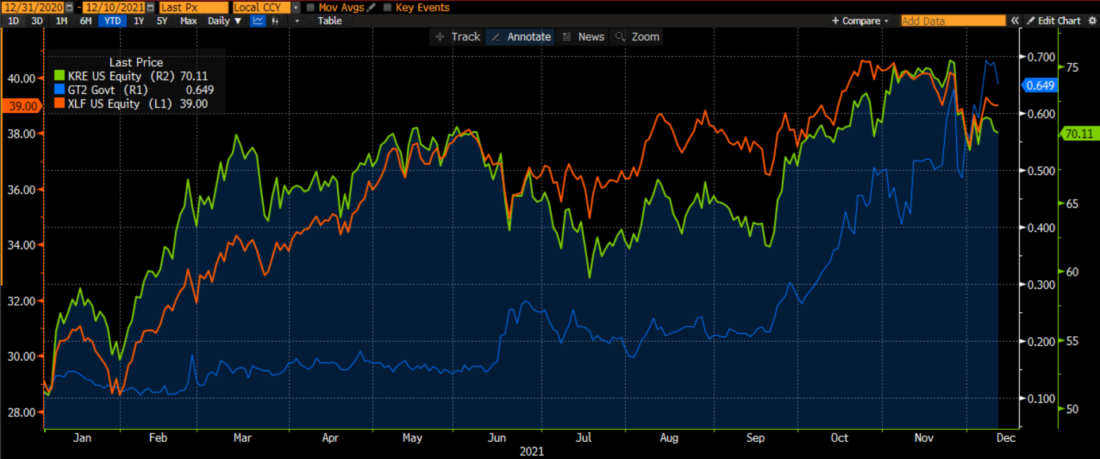Traders sometimes get sloppy with relationships, especially when they work superficially. One of those has been the relationship between the yield curve, specifically the spread between the yields on 2 and 10-year Treasury notes. There is logic to the idea that banks benefit if that spread widens. Banks tend to borrow short-term via demand deposits and the money markets, and lend long-term via mortgages and commercial loans. It therefore makes sense to think that a steepening yield curve benefits banks’ profits.
For most of the time since the Federal Reserve began its post-Covid monetary stimulus in March 2020, KRE, the SPDR S&P Regional Banking ETF, has been moving in tandem with the 2/10 spread, as shown below:
KRE (green, right) vs. 2/10 Spread (white, left) since April 2020

Source: Bloomberg
We see the two lines moving in near lockstep until last summer. At that point, KRE largely continued higher even as the 2/10 spread narrowed, and in recent weeks we have seen KRE remain solid even as the spread plunged. That is wonderful for those who have been long regional banks, but upending what appeared to be a solid trading relationship.
I believe there are two main reasons for the recent outperformance. First, equity markets overall have been robust. That makes investors more willing to overlook potentially detrimental news. But the second reason is better explained by the following graph:
KRE (green, left) vs 2-Year Yield (white, right), Year-to-Date


Source: Bloomberg
We see that KRE has begun to follow 2-year yields higher even as the spread with 10 year yields narrowed. There is a logical reason for this change in focus. While the 2/10 spread is a convenient shorthand for the spread relationship that banks utilize, it is not fully descriptive. Think about your checking account at a bank. You have likely not received a bump in the rates that you receive on the funds in your account, but the bank has likely received a boost in the amount that they can reinvest those funds in safe short-term assets. They are now able to earn a reasonable spread on customer deposits, which flows to the bottom line.
Some of you may be wondering why we have chosen to focus on KRE rather than XLF, the Financial Select Sector SPDR. The reason is that XLF is by no means a pure play on banks. There are many non-banks represented in the ETF, including its largest holding, Berkshire Hathaway (BRK.B), and others like Blackrock (BLK), Charles Schwab (SCHW), S&P Global (SPGI) and American Express (AXP). Furthermore, the “money-center” banks that are in this ETF are more dependent upon capital markets, investment banking, custody and other activities. Compare the relative performance of XLF to KRE and the 2/10 spread since April 2020:
KRE (green, right), XLF (orange, right), 2/10 Spread (white, left) since April 2020


Source: Bloomberg
XLF has been a steady performer, but not nearly as strong as KRE and not nearly as tied to the 2/10 spread. That said, XLF has benefitted from the rise in 2-year yields for the same reason that KRE did. Many of these companies borrow with demand deposits that have not risen along with their ability to invest these funds at better short-term rates:
KRE (green, left), XLF (orange, left), 2-Year Yield (white, right), Year-to-Date


Source: Bloomberg
The takeaway for traders is this: even if narratives produce consistent tradeable relationships, those relationships can change without warning. In this case, the break between KRE and the 2/10 spread, which had been rock solid, still benefitted those who were long KRE. It wasn’t that the relationship failed, it simply became more nuanced. And for those traders who applied the same logic that worked for KRE to the superficially similar XLF, the relationship was not nearly as fruitful.
Disclosure: Interactive Brokers
The analysis in this material is provided for information only and is not and should not be construed as an offer to sell or the solicitation of an offer to buy any security. To the extent that this material discusses general market activity, industry or sector trends or other broad-based economic or political conditions, it should not be construed as research or investment advice. To the extent that it includes references to specific securities, commodities, currencies, or other instruments, those references do not constitute a recommendation by IBKR to buy, sell or hold such investments. This material does not and is not intended to take into account the particular financial conditions, investment objectives or requirements of individual customers. Before acting on this material, you should consider whether it is suitable for your particular circumstances and, as necessary, seek professional advice.
The views and opinions expressed herein are those of the author and do not necessarily reflect the views of Interactive Brokers, its affiliates, or its employees.































